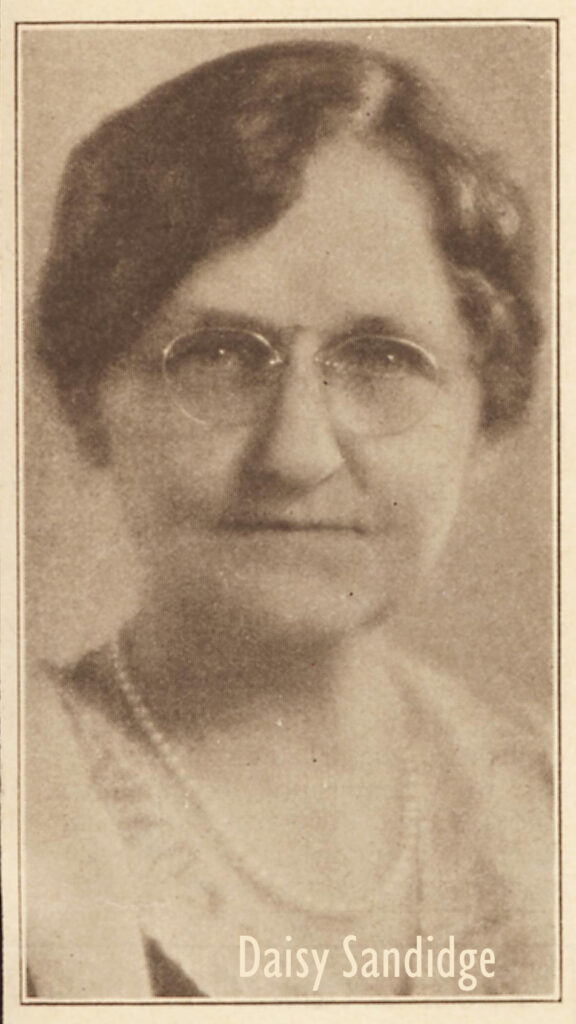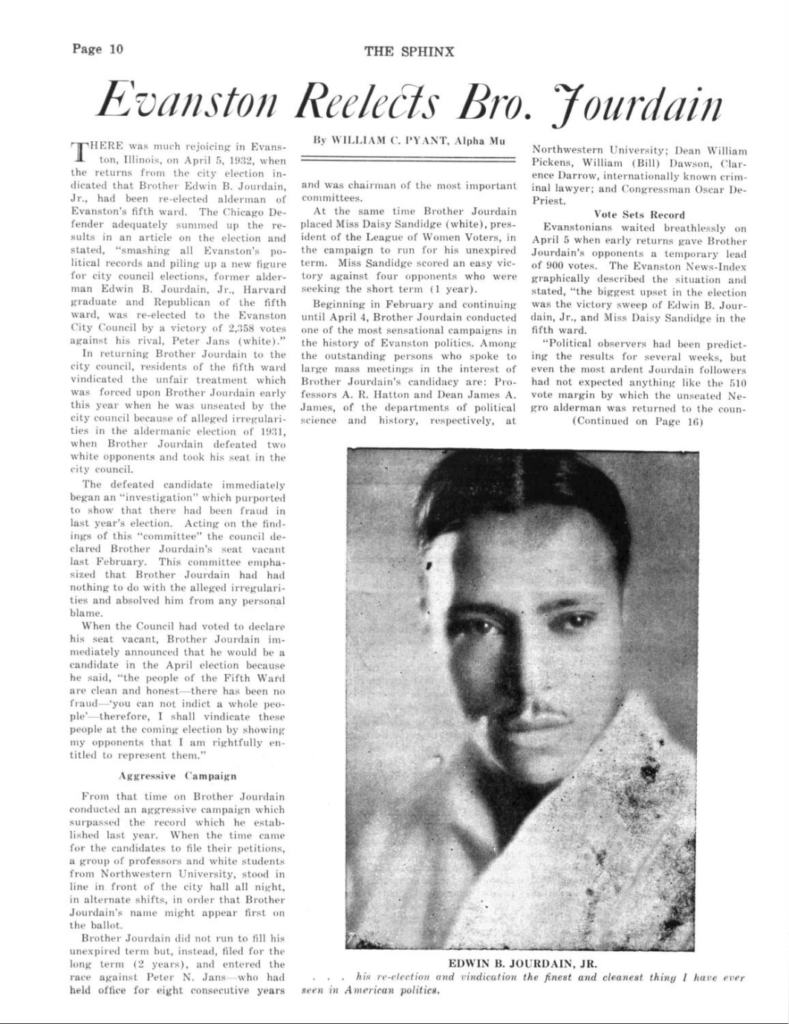By Sophia Weglarz, EWHP Summer 2021 Intern
“A Southern white woman and a young Negro man cooperating in politics against crookedness and against two cheap white male politicians, and being supported by all the blacks and all the most intelligent and influential whites of their ward! Ye gods! What is this country coming to?”[i]
This quote comes from a Spring 1932 article in The Sphinx, the magazine for the black fraternity Alpha Phi Alpha, whose membership included Edwin B. Jourdain, Evanston’s first black alderman. The article describes an unlikely alliance between Jourdain and Daisy Sandidge, Evanston’s first female alderwoman and the president of the League of Women’s Voters at the time. After Jourdain was elected alderman in 1931, he was ousted from the position for supposed election fraud. Jourdain, who had a career as an investigative journalist, embarked on a thorough investigation to prove his innocence, but in the meantime, he advised Sandidge to run for his unexpired term. She won with ease and held the seat for Jourdain until he ran again in the next election. After this win, Jourdain went on to be alderman for another 15 years, becoming an Evanston legend in the process. Sandidge, on the other hand, went into obscurity, and somehow the story of how Evanston elected its first female alderman went untold and unheard.

Born in Belton, Texas in 1877 to Andrew Jackson Sandidge and Mary Elizabeth Allen,[ii] Daisy Sandidge grew up in Texas and even attended the nearby Belton College. She later ventured to Chicago to attend the University of Chicago. Eventually, Sandidge found herself in Evanston in 1916 and stayed here until her death in 1947. She was heavily involved with the League of Women’s Voters and the Woman’s Club of Evanston, with both organizations hosting celebrations for her 1931 election win. Sandidge’s personal sphere of political interest centered around domestic issues that directly affected women and the home, where she sought to advocate for them in the public sphere from a woman’s perspective.
When she won Jourdain’s unexpired term, she said, “I know it is something of an innovation to have a woman seated on the city council, but my theory is that women have something to contribute to government, inasmuch as many of our municipal problems so directly affect the home.”[iii]
Following her win, Sandidge explained her reasons for running, saying, “Another reason for entering the aldermanic race was the fact that it appealed to me as being exceedingly worthwhile. For years I have been interested in good government, and I could not keep out of a struggle such as we have been faced with in the fifth ward and remain consistent with my ideas of duties of citizenship, especially since I have so frequently expressed myself on what I assumed those duties to be.”[iv]
Additionally, when Sandidge ran, she also clarified that she had no further political aspirations beyond carrying out Jourdain’s unexpired term. Instead, she intended to change the shady politics of the time that had allowed Jourdain to be ousted, saying, “Besides that, I hope to force the council to discontinue its practice of holding secret sessions and voting on a proposal after a debate in which the public is left in the dark.”[v]
Jourdain shared this sentiment, claiming that “The idea that Evanston is a well-governed city is a joke.”[vi]

Sandidge and Jourdain’s alliance set a precedent for Evanston politics, with the Evanston Review stating, “Regardless of the merits of the issues involved, the disposition of the newly elected aldermen from the fifth ward, Miss Daisy Sandidge and Edwin Jourdain, to do their own thinking and their own voting and to speak their minds, as shown in the first meeting of the new city council, is most encouraging.”[vii]
Beyond inspiring a new hope for the future of Evanston politics, Jourdain and Sandidge’s partnership was considered revolutionary for racial politics of the time. As the first quote suggested, the banding together of “Southern woman and a young Negro man” was a shocking, awe-inspiring even. The Sphinx would continue on to say, “It is clear that white Americans have shown in this instance the capacity to rise above race and color and to accord honor and reward according to merit. This is one of the most encouraging signs I have ever seen, and the support and enthusiasm for Jourdain’s re-election and vindication is simply the finest and cleanest thing I have ever seen in American politics.”[viii]
Jourdain and Sandidge’s aldermanic alliance also set the stage for other cross racial alliances in the 1950s and beyond. In my final blog post, I will be looking into how Evanston’s Black women’s organizations of the 1950s fit in with their white counterparts – where alliances between them existed and where they did not.
[i] Pyant, William C. May 1932. “Evanston Reelects Bro. Jourdain” 10.16.27. The Sphinx.
[ii] Evanston History Center, Archives and Collections: “Sandidge, Cora.” Biographical Files.
[iii] Pyant, William C. May 1932. “Evanston Reelects Bro. Jourdain”10.16.27. The Sphinx.
[iv] Evanston Index, April 14, 1932. “First Evanston Alderwoman in Evanston Tells Her Hopes for City, Ward.”
[v] Pyant, William C. May 1932. “Evanston Reflects Bro. Jourdain” 10.16.27. The Sphinx.
[vi] Ibid.
[vii] Evanston Index, April 7, 1932. “Daisy Will Tell.”
[viii] Pyant, William C. May 1932. “Evanston Reflects Bro. Jourdain” 10.16.27. The Sphinx.
